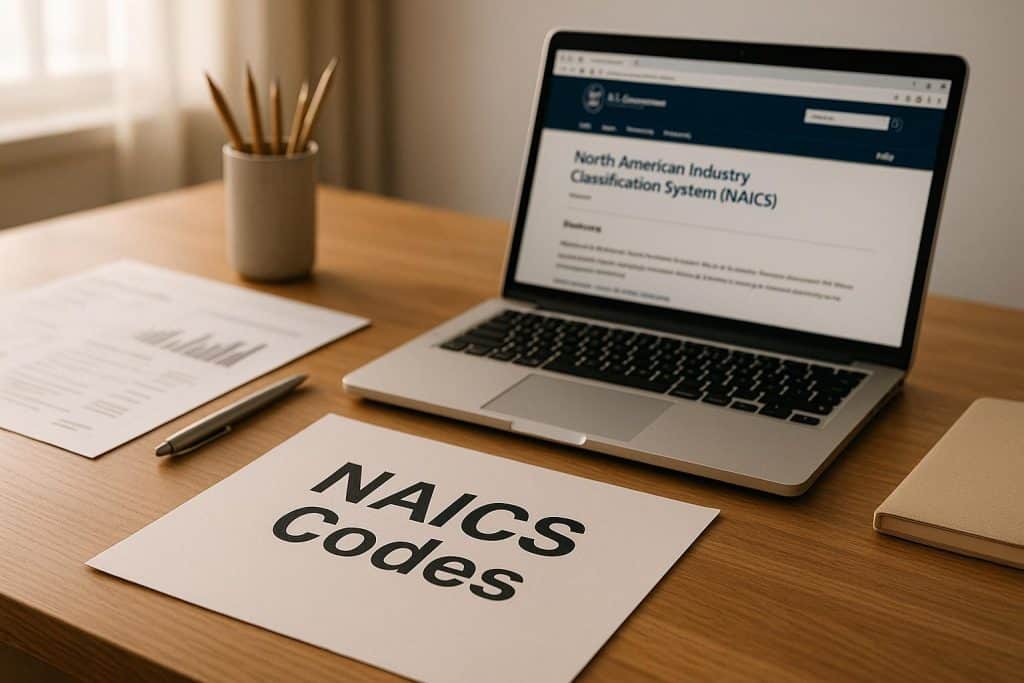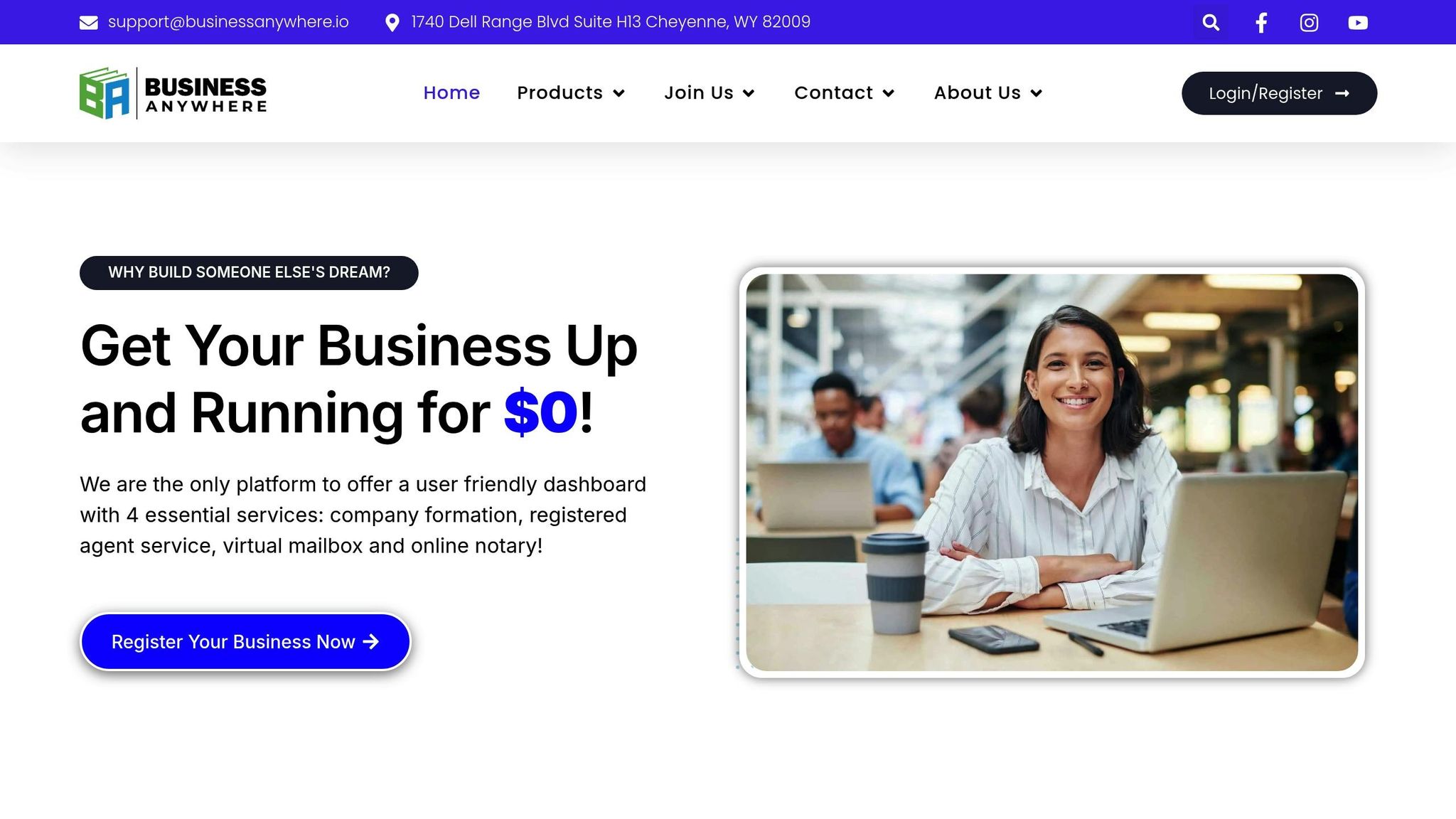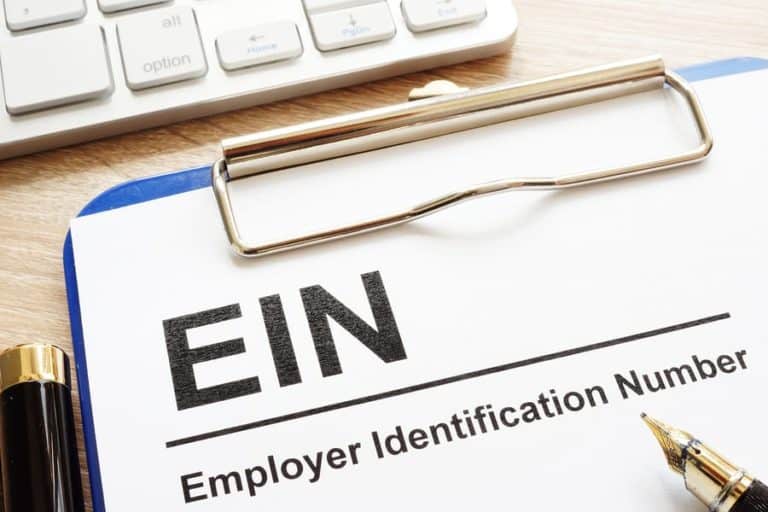NAICS (North American Industry Classification System) codes classify businesses based on their primary activities, helping governments and organizations analyze industries, award contracts, and offer tax benefits. Introduced in 1997, this 6-digit system is updated every five years to reflect economic changes. Here’s why NAICS codes matter:
- Business Registration: Essential for compliance, permits, and accessing government programs.
- Government Contracts: Determines eligibility for federal contracts and small business programs.
- Tax Benefits: Helps businesses qualify for industry-specific incentives.
- Loans & Risk Assessment: Lenders use NAICS codes to evaluate business risks and loan terms.
- Market Research: Provides insights into industry trends and competitive analysis.
Want to find the right NAICS code? Use the U.S. Census Bureau‘s search tool or consult the NAICS manual, ensuring it matches your main revenue-generating activity. Regularly update your code to stay compliant and unlock opportunities.
How NAICS Codes Are Organized
The NAICS system is built on a hierarchical structure, starting with broad economic categories and narrowing down to highly specific business activities. This design ensures a consistent and systematic way of classifying businesses across the United States, Canada, and Mexico. Let’s break down the 6-digit code system that drives this classification.
The 6-Digit Code System
Each NAICS code consists of six digits, with each digit adding a layer of specificity. The system begins with 20 broad sectors and drills down into 1,012 specific national industry codes.
Here’s how the structure works:
- First Two Digits (Sector): These represent the broadest economic categories. For instance, codes 44-45 encompass all Retail Trade businesses, while 54 covers Professional, Scientific, and Technical Services, which includes over 2.4 million U.S. entities.
- Third Digit (Subsector): This introduces the first level of detail within each sector, dividing it into 96 subsectors.
- Fourth Digit (Industry Group): At this level, businesses with similar activities are grouped into 308 industry groups.
- Fifth Digit (NAICS Industry): This stage defines 689 industry codes that are consistent across the United States, Canada, and Mexico.
- Sixth Digit (National Industry): The final digit provides country-specific details, resulting in 1,012 six-digit codes in the U.S. system.
| Level | Digits | Example Code | Description | Total Codes |
|---|---|---|---|---|
| Sector | 2 | 44‑45 | Retail Trade | 20 |
| Subsector | 3 | 441 | Motor Vehicle and Parts Dealer | 96 |
| Industry Group | 4 | 4412 | Other Motor Vehicle Dealers | 308 |
| NAICS Industry | 5 | 44122 | Motorcycle, Boat, and Other Motor Vehicle Dealers | 689 |
| National Industry | 6 | 441222 | Boat Dealers | 1,012 |
Common NAICS Code Examples
Let’s look at a real-world example to see how the NAICS system works. A boat dealership falls under the code 441222, classified as follows:
- 44‑45: Retail Trade (Sector)
- 441: Motor Vehicle and Parts Dealer (Subsector)
- 4412: Other Motor Vehicle Dealers (Industry Group)
- 44122: Motorcycle, Boat, and Other Motor Vehicle Dealers (NAICS Industry)
- 441222: Boat Dealers (National Industry)
The NAICS system evolves to keep up with economic changes. For example, in 2012, crude petroleum extraction was divided into 211120 and 211130, while in 2017, electronic shopping codes were consolidated under 454110. These updates reflect NAICS’ ability to adapt to new business trends.
Additionally, some sectors are so large and complex that they span multiple two-digit codes. These include Manufacturing (31‑33), Retail Trade (44‑45), and Transportation and Warehousing (48‑49). This hierarchical design not only helps businesses pinpoint their exact classification but also enables government agencies to analyze data at various levels – from broad sector trends to detailed industry performance. This clarity is key to NAICS’ role in supporting business operations and compliance efforts.
NAICS Codes for Business Formation and Compliance
NAICS codes play a crucial role in forming and maintaining a business in the United States. These six-digit codes are more than just industry identifiers – they’re key to accessing benefits, meeting regulatory requirements, and determining eligibility for loans and federal contracts. Let’s break down how these codes influence business registration, permits, and financial assessments.
Business Registration Requirements
Choosing the correct NAICS code is a foundational step when starting a business. It shapes how your company is classified and can open doors to various opportunities. As the General Services Administration explains:
NAICS codes are used to communicate your industry and find opportunities through various resources.
Similarly, the U.S. Small Business Administration highlights their purpose:
NAICS codes classify businesses based on the particular product or service they supply.
When registering your business, it’s essential to align your primary activity with the right NAICS code. If your operations span multiple industries, you can register more than one code. This flexibility ensures compliance with industry-specific rules while unlocking opportunities tailored to each code. Keeping your records accurate and up to date is critical, as it directly impacts compliance and eligibility.
Permits, Contracts, and Tax Benefits
NAICS codes don’t just matter at the registration stage – they also influence permits, government contracts, and tax advantages. According to NAICS.com:
Accurate NAICS codes are crucial for businesses to access specific tax benefits and incentives.
For companies aiming to sell to government agencies, having the correct NAICS code is mandatory. Federal agencies, for instance, spend over $40 billion annually through the GSA Multiple Award Schedule Contract . These codes also unlock tax incentives. A notable example is New York’s Energy Cost Savings Program, which offers eligible businesses energy cost reductions of up to 45 percent – but only if they provide a valid NAICS code during the application process.
Loans and Industry Risk Assessment
NAICS codes also play a pivotal role in shaping your financial profile. Lenders use these codes to evaluate the risk associated with your business and to determine loan terms. Based on your NAICS classification, financial institutions may categorize your business as preferred, normal risk, high risk, or even prohibited . This categorization impacts everything from loan approval to interest rates, collateral requirements, and loan amounts.
As Martin Guzman, Head of Community, explains:
Incorrect NAICS codes can lead to missed funding opportunities or higher borrowing costs.
Additionally, lenders often impose industry concentration limits, restricting the total amount of loans they issue within certain sectors to avoid overexposure. An inaccurate NAICS code can also hurt your business credit profile, as credit scores are influenced by the industry you operate in. The Small Business Administration uses these codes to determine size standards, which affect eligibility for small business programs and government contracts.
To avoid potential pitfalls, it’s important to review and update your NAICS classification regularly.
How to Find the Right NAICS Code
To choose the correct NAICS code for your business, you need to pinpoint your primary business activity. Since the U.S. Census Bureau doesn’t assign or monitor NAICS codes, it’s up to you to find the code that best aligns with what your business does. This involves understanding the classification structure and ensuring it accurately represents your operations.
Research and Selection Process
Start by using the U.S. Census Bureau’s NAICS search tool to narrow down codes with relevant keywords. Keep in mind, NAICS codes are updated every five years to reflect shifts in the economy.
Begin your search with broad terms related to your business. If nothing comes up, simplify your keywords. For instance, instead of searching for "artisanal coffee roasting", try "coffee" or "food manufacturing." You can also explore the full list of NAICS Codes and Titles to find the best match.
If your business previously used the older Standard Industrial Classification (SIC) system, a crosswalk tool can help you find the equivalent NAICS code. Once you’ve identified potential codes, review the full industry descriptions in the NAICS manual. Pay attention to the narrative details, cross-references, and examples to confirm the code fits your business’s main activity.
Still unsure? Reach out to the Census Bureau for guidance by calling 1-888-756-2427 or emailing [email protected].
Matching Your Business Activities
After researching, ensure the code you select reflects your main source of revenue. This is crucial because your NAICS code should represent the activity that contributes most to your income. NAICS codes range from two to six digits, with the longer codes offering more specific classifications. For example, a manufacturing business might start with sector 31-33 (Manufacturing), then narrow it down to 311 (Food Manufacturing), and finally to 311513 (Cheese Manufacturing) if cheese production is its primary focus.
For businesses involved in multiple industries, you can register more than one NAICS code. However, be sure to designate one as your primary code – this should represent the activity that generates the most revenue. Carefully review the descriptions and examples in the NAICS manual to make the best choice. If more than one code seems applicable, pick the one that most closely aligns with your main business activity.
Updating Your NAICS Code
As your business grows or changes, you might need to update your NAICS code. To do this, you’ll need to contact every organization where you’ve previously provided the code.
Government agencies rely on NAICS codes to inform businesses about tax incentives, loans, and regulatory updates. Using an outdated or incorrect code could mean missing out on benefits or running into compliance problems.
For businesses using E-Verify, updating your NAICS code is simple – just enter the new three-digit code in your company profile and save the changes. If you’re unsure of the updated code, you can use the lookup tool available within the system.
Regularly reviewing your NAICS classification is a smart practice, especially during the five-year update cycles when codes are revised or new ones are introduced. This ensures your business stays aligned with current classifications and avoids potential issues.
sbb-itb-ba0a4be
Using NAICS Codes in Practice
Once you’ve identified the correct NAICS code – a key step for registration and compliance – it’s time to put it to use across your business operations. This code will appear on various forms, applications, and compliance documents throughout your company’s lifecycle.
Business Forms and Tax Filings
Your NAICS code plays a vital role in tax filings and business registrations. The IRS uses these codes to compare your business’s tax returns with others in the same industry.
Choosing the correct NAICS code ensures your tax filings are accurate and that you qualify for industry-specific deductions and credits. Tax authorities rely on NAICS codes to assess and grant incentives tailored to specific industries. On the flip side, selecting the wrong code could mean missing out on potential benefits.
To avoid issues, carefully review the NAICS code descriptions and pick the one that best matches your primary business activities. If your business operates across multiple industries, use the code that reflects the largest source of your revenue. Misclassification can lead to compliance problems and limit your access to certain benefits.
When filing foundational business documents, such as Articles of Incorporation or LLC Operating Agreements, you’ll often need to provide your NAICS code. State agencies use this information to determine your business type and ensure you meet any industry-specific requirements.
Accurate classification not only ensures proper tax treatment but also positions your business to secure government contracts.
Government Contracts and Grants
For businesses pursuing government contracts, your NAICS code is a critical factor. It determines your eligibility for small business set-asides and other programs.
Registering on SAM.gov with the correct NAICS codes is essential, as agencies use these codes to classify contract opportunities, including those reserved for small businesses. To increase your chances of success, use the NAICS lookup tool to find the codes that align most closely with your core business activities. If your company operates in multiple sectors, designate a primary NAICS code based on the product or service that generates the most revenue. Make sure your codes are accurately listed in SAM and align with any federal certifications.
NAICS codes are also valuable for market research. They help you analyze government spending in your category, identify active agencies, and recognize current government vendors. For instance, in June 2025, the General Services Administration updated its Multiple Award Schedule Contract to include approximately 300 NAICS codes, grouping products and services by Special Item Numbers that correspond to specific NAICS codes.
Keeping your NAICS codes up to date is crucial for staying eligible for contracts and remaining competitive. Monitor updates to avoid missing opportunities – the next NAICS revision is scheduled for 2027.
Managing Compliance with Business Anywhere
Beyond paperwork and contracts, staying compliant with NAICS requirements is crucial for long-term success. Managing these requirements can be complex, but Business Anywhere simplifies the process by integrating compliance management into a single, user-friendly platform.
With its compliance alerts feature, the platform tracks deadlines and requirements tied to your NAICS classification, ensuring you meet filing and update deadlines on time. The document management dashboard allows you to organize and store all NAICS-related paperwork, from initial registration forms to government contract applications, helping you maintain consistency across your records.
Business Anywhere also offers registered agent services, ensuring you promptly receive any official correspondence related to your industry classification or compliance requirements. This is especially important for businesses in government contracting, where timely communication can make all the difference. By centralizing NAICS code updates, compliance tasks, and related documentation, Business Anywhere helps reduce errors and keeps your business properly classified as it grows and evolves.
Conclusion
NAICS codes play a critical role in classifying businesses across the United States, linking your company to specific opportunities and benefits. This six-digit system is a cornerstone for federal and state agencies, guiding processes like tax filings and contract awards. By choosing the correct code that aligns with your primary revenue-generating activities, you open doors to industry-specific tax breaks, government contracts, and specialized programs – all of which can have a direct impact on your business’s financial health. Accurate classification ensures smoother operations and better access to these resources.
On the flip side, errors in classification can lead to serious consequences. Regulatory penalties, missed funding opportunities, higher borrowing costs, and insurance challenges are just a few examples. For instance, if a roofing company is mistakenly classified as a carpentry business, it could face denied insurance claims, potentially leading to significant financial losses. Additionally, an incorrect classification can hurt your business credit score, as industry codes are often a factor in its calculation.
Given the importance of staying up to date, it’s worth noting that NAICS codes are updated every five years. Regularly reviewing your classification ensures compliance and helps you continue to take full advantage of the benefits tied to your specific industry.
No matter the stage of your business, dedicating time to select and maintain the right NAICS code is a strategic move. It’s not just an administrative box to check – it’s a decision that can influence your eligibility for growth-driving programs, federal contracts, and other valuable opportunities. Treat your NAICS classification as a vital part of your business strategy.
FAQs
How can I find the right NAICS code for my business if it operates in more than one industry?
To determine the correct NAICS code for a business operating in multiple industries, start by identifying your primary business activity – the one that brings in the most revenue or best represents your core operations. Once you’ve nailed this down, use a NAICS code lookup tool to find the code that aligns most closely with that activity.
If your business is involved in various industries, you can also assign secondary NAICS codes to cover those additional activities. However, your primary code should always reflect the central focus of your business. This ensures proper classification for government records, tax filings, and contract opportunities, while keeping you aligned with federal regulations.
What happens if I use the wrong NAICS code for my business?
Using the wrong NAICS code can spell trouble for your business. For starters, it can lead to misclassification, which might block you from accessing government contracts, industry-specific programs, or even tax breaks that are tailored to your field. For example, if your code doesn’t properly represent your main business activities, you could miss out on opportunities meant specifically for businesses in your industry.
On top of that, an incorrect NAICS code can bring about compliance headaches. Regulatory agencies might flag your business for further scrutiny, and in some cases, this could result in fines or even legal challenges. To avoid these pitfalls, it’s essential to choose a NAICS code that closely aligns with your operations and industry focus.
How often should I update my NAICS code to stay compliant and take advantage of benefits?
It’s smart to revisit and update your NAICS code annually or whenever your business experiences major changes – like switching primary activities or branching into a new industry. Staying current with your code not only keeps you compliant with regulations but also opens doors to opportunities such as government contracts, tax breaks, or programs tailored to specific industries. Plus, keeping your classification accurate can make tasks like permitting and reporting much smoother.








